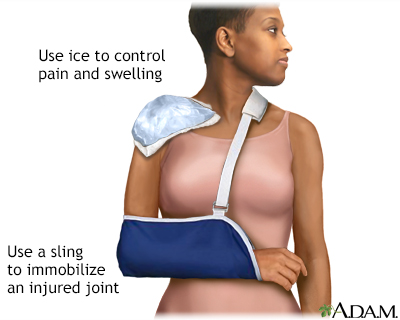Reverse total shoulder replacement - discharge
You had reverse shoulder replacement surgery to replace your shoulder joint with artificial joint parts. The parts include a stem made of metal and a metal ball that is secured into your shoulder bone. The joint is then connected with a plastic liner that acts as a bearing.
Now that you're going home, be sure to follow your surgeon's instructions on how to take care of your new shoulder. Use the information below as a reminder

After a shoulder injury you may be fitted with a shoulder sling to help immobilize the joint to aid in the healing process. Your provider may advise you to apply ice to help ease pain and swelling.
When You’re in the Hospital
While in the hospital, you should have received pain medicine. You also learned how to manage swelling around your new joint.
Your health care provider or physical therapist may have taught you exercises to do at home.
What to Expect at Home
Your shoulder area may feel warm and tender for 2 to 4 weeks. The swelling should go down during this time. You will also have bruising that will go down the inside of your arm and chest a few days after surgery. This is normal and expected after a replacement. You may want to make some changes around your home so it's easier for you to take care of yourself.
Arrange for someone to help you with daily tasks such as driving, shopping, bathing, making meals, and housework for up to 6 weeks.
Activity
You will need to wear a sling for the first 6 weeks after surgery. Rest your shoulder and elbow in front of a rolled up towel or small pillow when lying down. This keeps your arm and hand at the same level as your body.
Keep doing the exercises you were taught for as long as you were told. This helps strengthen the muscles that support your shoulder and ensures the shoulder heals well.
Follow instructions on safe ways to move and use your shoulder.
You may not be able to drive for at least 4 to 6 weeks. Your surgeon or physical therapist will tell you when it's OK.
Consider making some changes around your home so it's easier for you to take care of yourself.
Ask your surgeon about which sports and other activities are OK for you after you recover.
Pain
Your surgeon will give you a prescription for pain medicines. Get it filled when you go home so you have it when you need it. Take the pain medicine when you start having pain. Waiting too long to take it allows the pain to get worse than it should.
Narcotic pain medicine (for example. codeine, hydrocodone, and oxycodone) can make you constipated. If you are taking them, drink plenty of fluids, and eat fruits and vegetables, and other high-fiber foods to help keep your stools loose.
Do not drink alcohol or drive if you're taking these pain medicines. These medicines may make you too sleepy to drive safely.
Taking ibuprofen (Advil, Motrin) or other anti-inflammatory medicines with your prescription pain medicine may also help. Your provider may also give you aspirin to prevent blood clots. Stop taking anti-inflammatory medicines if you take aspirin. Follow instructions exactly on how to take your medicines.
Wound Care
Sutures (stitches) or staples will be removed about 1 to 2 weeks after surgery.
Keep the dressing (bandage) over your wound clean and dry. Change the dressing only if instructed.
- Do not shower until after your follow-up appointment with your surgeon. Your surgeon will tell you when you can begin taking showers. When you do, let the water run over the incision. Do not scrub.
- Do not soak your wound in the bathtub or a hot tub for at least the first 3 weeks.
When to Call the Doctor
Contact your surgeon or provider if you have any of the following:
- Bleeding that soaks through your dressing and doesn't stop when you place pressure over the area
- Pain that doesn't go away when you take your pain medicine
- Numbness or tingling in your fingers or hand
- Your hand or fingers are darker in color or feel cool to the touch
- Swelling in your arm
- Your new shoulder joint doesn't feel secure like it's moving around, shifting, or out of position
- Redness, pain, swelling, or a yellowish discharge from the wound
- Temperature higher than 101°F (38.3°C)
- Shortness of breath
References
American Academy of Orthopaedic Surgeons website. Treatment: reverse total shoulder replacement.
Chan WW, Namdari S, Leggin BG, et al. Surgical and postoperative management of shoulder arthritis. In: Skirven TM, Osterman AL, Fedorczyk JM, Amadio PC, Feldscher SB, Shin EK, eds. Rehabilitation of the Hand and Upper Extremity. 7th ed. Philadelphia, PA: Elsevier; 2021:chap 89.
Duquin TR, Matsen FA, Lippitt SB, Rockwood CA, Wirth MA. Evaluation and management of glenohumeral arthritis. In: Matsen FA, Cordasco FA, Sperling JW, et al, eds. Rockwood and Matsen's The Shoulder. 6th ed. Philadelphia, PA: Elsevier; 2022:chap 60.
Throckmorton TW. Shoulder and elbow arthroplasty. In: Azar FM, Beaty JH, eds. Campbell's Operative Orthopaedics. 14th ed. Philadelphia, PA: Elsevier; 2021:chap 12.
Version Info
Last reviewed on: 6/4/2025
Reviewed by: C. Benjamin Ma, MD, Professor, Chief, Sports Medicine and Shoulder Service, UCSF Department of Orthopaedic Surgery, San Francisco, CA. Also reviewed by David C. Dugdale, MD, Medical Director, Brenda Conaway, Editorial Director, and the A.D.A.M. Editorial team.
